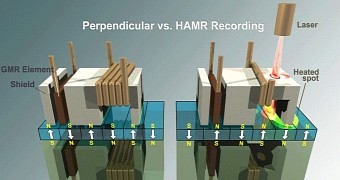It seems that Seagate pushes forward in the battle between the HDDs and SSDs, announcing a new technological breakthrough in building future HDDs with three or four times more storage space than the ones available today.
Called HAMR or Heat-Assisted Magnetic Recording, it is a new process of writing data on the magnetic media of classical hard disk platters. According to Heise.de, Jan-Ulrich Thiele, the head of HAMR development at Seagate, said that HDDs featuring HAMR wouldn’t be made to break storage sizes records, but would rather be made to evaluate the technology when massed produced.
Planned to be introduced in late 2016, the first prototypes of HAMR HDDs will arrive in limited 4TB storage sizes, and the writing head with laser will be slightly thicker than traditional heads. Because of this, the first generation of HAMR-based hard disk drives will have an increased distance between discs, and therefore, the general form factor will be larger than contemporary HDDs.
The HAMR process consists, in short, in heating the magnetic media platters before writing the data to about 450°C using a laser with 810mm wavelength and 20mW power.
HAMR starts small, but by 2025 it will reach 100TB
It seems that shipments of HAMR-based hard drives will start in 2018 after the tests started in 2016 probably end in 2017 and demonstrate whether HAMR tech is ready for mass production or not. To beat the rapid advancement of SSDs driven forward by Samsung, Seagate plans to make the new drives available only to select cloud and hyperscale datacenter customers, and only after that, the technology will move to the wide spread consumer market.
Apparently, the HAMR technology is only a first step of development for HDDs since ASTC (Advanced Storage Technology Consortium) that consists of a group of multiple HDD manufacturers plans a further HDD development beyond the current 10TB+ storage sizes spanning until 2025 and beyond, promising storage sizes reaching 100TB+ in ten years from now.
It seems the HDD alliance won’t give up in their competition against the South Korean giant Samsung that just launched its first 16TB SSD as the biggest hard disk on the planet and promises that in three years from now SSD 3D VNAND storage sizes will reach 128TB.

 14 DAY TRIAL //
14 DAY TRIAL //